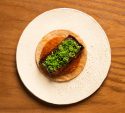Chicken, apricot & pork pie
Contains pork – recipe is for non-Muslims only
Make your own layered pork pie using sausages, fruit, chicken fillets and ham with hot water crust pastry – perfect for parties and picnics
-
Prep:2 hrs
Cook:1 hrs 30 mins
plus chilling - A challenge
Nutrition per serving
-
kcal 465
-
fat 21g
-
saturates 8g
-
carbs 40g
-
sugars 7g
-
fibre 3g
-
protein 29g
-
salt 3.6g
Ingredients
- 3 good-quality sausage (200g) meat squeezed from the skins (we used free-range British Cumberland)
- 250g pack or 8 rashers good-quality dry-cure back bacon, roughly chopped
- 300g ham (leftover from a joint is perfect), half chopped into 1cm pieces, the rest roughly chopped
- 1 tsp ground mace
- 1 tsp ground pepper
- ½ small pack curly parsley, finely chopped
- 400g pack mini chicken fillet
- 18 soft dried apricot
- 3 gelatine leaf
- 1 chicken stock cube
- 450g plain flour, plus extra for dusting
- 100g lard, plus extra for greasing
- 4 tbsp milk
- 1 egg, beaten
- 450g metal loaf tin
- rolling pin
- metal piping nozzle
- pastry brush
- baking parchment
- small funnel (optional)
Tip
Pastry adviceThe pastry is most malleable when still warm – so, along with wrapping in cling film to stop it drying out, I also over-wrap in a tea towel to keep the heat in.
The perfect finishIf the sides of the loaf are a little pale after cooking, cooling and removing from the tin, heat oven to 200C/180C fan/gas 6, brush the sides with some egg yolk and bake for another 15-30 mins before cooling again.
Method
Make the pork filling. Put the sausagemeat, bacon and roughly chopped ham into a food processor with the mace, pepper and a small amount of salt. Pulse until it is all coarsely chopped. Stir in the pieces of ham and the parsley.
To make the pastry, tip the flour into a bowl with 2 tsp salt. Put the lard and milk in a pan with 150ml water, then heat gently until the lard has melted, but don’t let it boil. Pour the hot liquid into the flour mixture, while beating with a wooden spoon.
Use your hands to knead until the dough comes together smoothly. Use a little more lard to grease the loaf tin, then line it with a long strip of baking parchment that comes well over the edge of the tin at each end – this will help you to lift out the pie. Dust inside the tin with the finest dusting of flour, too.
Dust your surface with flour. Wrap a third of the dough in cling film, then a tea towel (see tip, below), then roll out the rest to roughly 1.5cm thick. Roll the pastry over the rolling pin to help you lift over and into the tin. Use your hands to mould the pastry into the tin, pressing it firmly into the corners and easing it neatly up the sides to give an even thickness and overhang all the way around.
Start layering up the pie with roughly a quarter of the pork filling, pressing into a firmly packed, even layer at the bottom. Top with just over half of the chicken fillets – you can cut them to fit if you need to. Sandwich them together like a jigsaw puzzle, so that wherever you eventually slice into the finished pie, you get a perfect stripe of each different layer.
Follow the chicken strips with a second quarter of the pork. Again, try to press into a well-packed, even layer without disturbing the pastry too much. Now put in the apricots. Fit them in snugly, to once again create an even layer with no visible gaps.
Top the apricots with just over half the remaining pork mixture – this will probably take you over the top of the tin. Add the final layer of chicken fillets down the middle, starting to round the filling toward the centre. Finally, pile on the remaining pork and mould with your hands into a neat, firm dome.
Heat oven to 200C/180C fan/gas 6. Roll out the remaining pastry on a floured surface to a little bigger than the top of the pie. Brush some egg over the overhanging pastry edges on the pie, then lift on your pastry lid.
Use your hands to smooth over the top, pressing out any air, then press the edges well to seal. Using a small, sharp knife, and holding the whole tin in your hand so you can rotate it, cut away the excess pastry neatly by running your knife along the edge of the tin.
Crimp the edge of your pastry by using your index finger to create a ‘divot’, while pinching around it with two fingers from your other hand. Work all the way around the edges – this looks pretty, but also helps to seal the edges even more.
Finally, make a small hole in the centre of the pie and insert a metal piping nozzle into it. Brush the top all over with more beaten egg, then bake in a shallow roasting tin for 30 mins, before lowering the temperature to 180C/160C fan/gas 4 and cooking for another hour. Leave to cool (see tip, below), then use the paper to help lift out the pie – although once cool, you should be able to tip it out upside down onto your hand.
Soften the gelatine leaves in some cold water and pour 500ml boiling water over the stock cube to make stock. Squeeze the excess water from the leaves and stir into the stock to dissolve. Cool to room temperature, then sit a small funnel into your nozzle (unless you have a steady hand) and gradually pour in a little at a time into your pie until no more will go in. Remove the nozzle and chill for at least 4 hrs, or overnight.





















